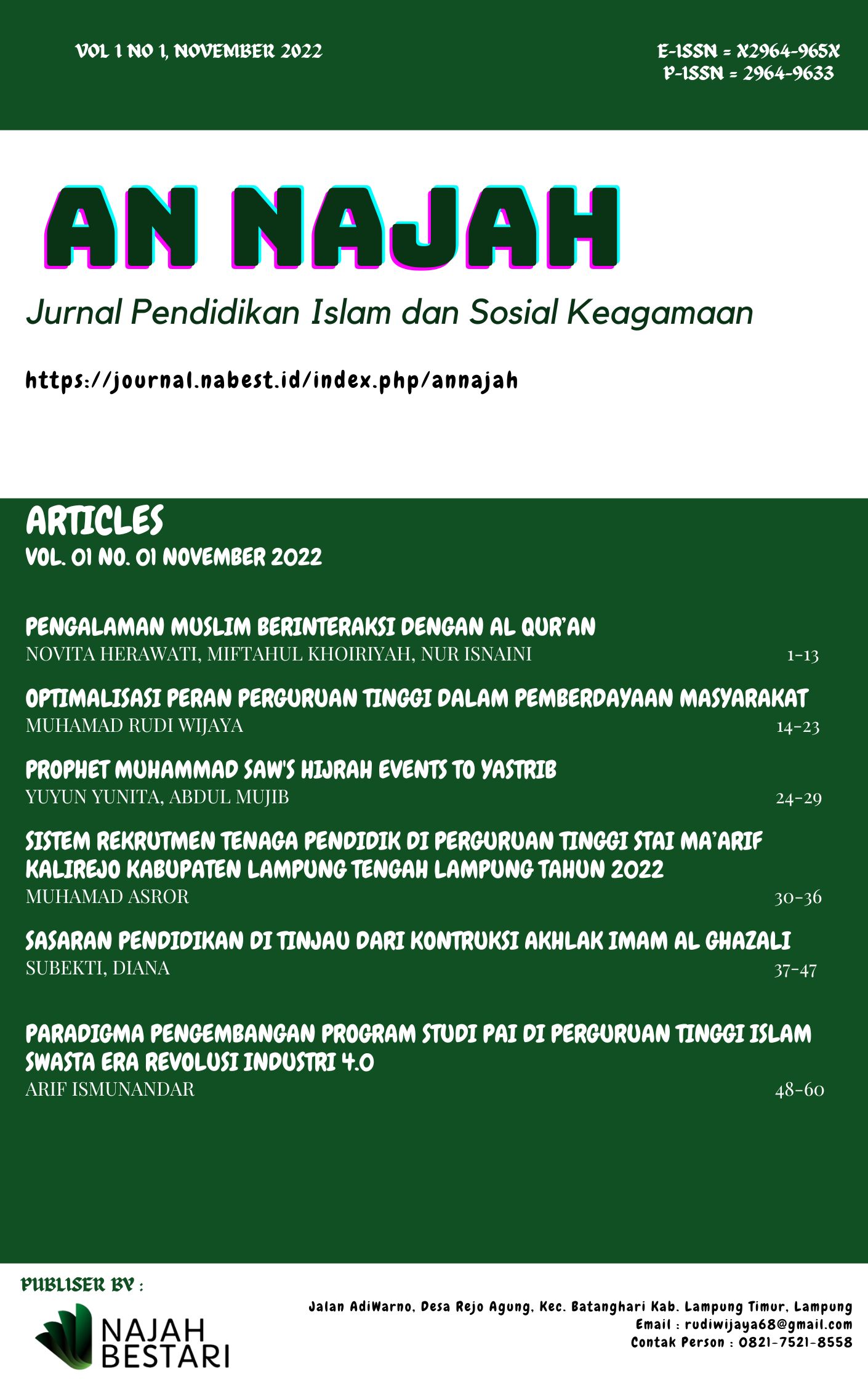TAREKAT AS A MULTICULTURAL SPACE: A LITERATURE STUDY ON THE INTEGRATION OF DIVERSITY VALUES IN SUFISM
Keywords:
Multiculturalism, Sufi Orders, Cultural Integration, Tolerance, Social HarmonyAbstract
This study investigates the role of tarekat (Sufi orders) as multicultural spaces that integrate diverse values within Islamic mysticism. Through an extensive literature review, the research examines how tarekat, with their inclusivity and adaptability, foster cultural and social harmony. By exploring existing literature on the integration of various cultural practices in Sufism, the study highlights the capacity of tarekat to bridge cultural divides and promote intercultural understanding. The findings underscore tarekat’s role as a model for tolerance and unity, revealing how spirituality and cultural diversity coalesce to foster cohesive community bonds within these orders
References
Adamu, A. Y. (2023). Student Ethnic Diversity Management in Ethiopian Universities: Practices, Challenges, and Way Forward. Higher Education, 86(6), 1325–1340. https://doi.org/10.1007/s10734-022-00974-x
Alam, S. (Ed.). (2019). Cultural Fusion of Sufi Islam: Alternative Paths to Mystical Faith (1st ed.). Routledge. https://doi.org/10.4324/9780429463549
Aleman, E. (2012). Linking Cultural Diversity and Innovation: A Literature Review. SSRN Electronic Journal. https://doi.org/10.2139/ssrn.2431584
Bensaid, B. (Corresponding A., & Machouche, S. (2019). MUSLIM MORALITY AS FOUNDATION FOR SOCIAL HARMONY. Journal of Al-Tamaddun, 14(2), 51–63. https://doi.org/10.22452/JAT.vol14no2.5
Corbin, H. (2021). Cyclical Time and Ismaili Gnosis (1st ed.). Routledge. https://doi.org/10.4324/9781003209560
Dunne, C. (2013). Exploring motivations for intercultural contact among host country university students: An Irish case study. International Journal of Intercultural Relations, 37(5), 567–578. https://doi.org/10.1016/j.ijintrel.2013.06.003
Dutta, U. (2019). Sufi and Bhakti Performers and Followers at the Margins of the Global South: Communication Strategies to Negotiate Situated Adversities. Religions, 10(3), 206. https://doi.org/10.3390/rel10030206
Fadzil, N. A., Abdul Hamid, M. F., Ahmad Zahidi, M. D., Norbit, A. N., & Abu Bakar, A. M. (2021). The Relationship Between Knowledge and Perception of the People of Melaka on The Concept of Sufi Order. International Journal of Academic Research in Business and Social Sciences, 11(9), Pages 1652-1659. https://doi.org/10.6007/IJARBSS/v11-i9/10845
Gurin, P., Nagda, B. (Ratnesh) A., & Lopez, G. E. (2004). The Benefits of Diversity in Education for Democratic Citizenship. Journal of Social Issues, 60(1), 17–34. https://doi.org/10.1111/j.0022-4537.2004.00097.x
Haiyan, H., Nyak Umar, M., & Jamali, Y. (2023). Kontribusi Nilai-Nilai Thariqat Naqshabandiyah pada Pembinaan Akhlak Santri Pondok Pesantren Darul Muta’allimin Kabupaten Aceh Singkil. Tadabbur: Jurnal Peradaban Islam, 5(1), 661–673. https://doi.org/10.22373/tadabbur.v5i1.346
Hamzah, Z. (2018). Interaction of Islam with Local Culture. AJIS: Academic Journal of Islamic Studies, 3(1), 1. https://doi.org/10.29240/ajis.v3i1.482
Hossain, I. U. (2021). Identities of Composite literary tradition during the Sultanate of Delhi: A study of Amir Khusrau and Kabir in the making of Indian heritage. International Journal of Historical Insight and Research, 7(1), 37–48. https://doi.org/10.48001/ijhir.2021.07.01.005
Khan, A. Y., Ida, R., & Saud, M. (2020). The Discussion on Concept of Women Rights in Islamic Sufism: Proceedings of the International Joint Conference on Arts and Humanities (IJCAH 2020). International Joint Conference on Arts and Humanities (IJCAH 2020), Surabaya, East Java, Indonesia. https://doi.org/10.2991/assehr.k.201201.182
Khan, S. A. (2020). Institutional Sufism in Contemporary Pakistan: Theorizing Gender through Practice. Pakistan Journal of Gender Studies, 20(1), 129–154. https://doi.org/10.46568/pjgs.v20i1.44
Kurniawan, R., Wisadirana, D., Kanto, S., Kholifah, S., & Umanailo, M. C. B. (2022). The ulama of Palembang Sammaniyah order: Survival in the middle of the regime of power in the 20th century. HTS Teologiese Studies / Theological Studies, 78(4). https://doi.org/10.4102/hts.v78i1.7542
Laksono, A. (2013). MULTIKULTURALISME DALAM SASTRA KONTEMPORER AMERIKA: Analisis Kumpulan Cerita Pendek Karya Brian Leung. Sabda : Jurnal Kajian Kebudayaan, 8(1), 29. https://doi.org/10.14710/sabda.v8i1.13235
Leu, S. (2010). Exploring Bicultural Experiences: Responding to a Chinese American Young Adult Novel. Language and Literacy, 12(1), 57. https://doi.org/10.20360/G2MW2S
Li, J. T. (2018). Introduction: Garnering Diversities in Comparative Literature. Canadian Review of Comparative Literature / Revue Canadienne de Littérature Comparée, 45(2), 191–196. https://doi.org/10.1353/crc.2018.0018
Mohamad, M. Z., Teh, K. S. M., Yusof, S., Hasan, A. F., Salleh, A. Z., & Ghazali, A. B. (2018). Building a Personality by Installing Noble Values: Implementing Nursi’s Thoughts in a Malaysia Context. International Journal of Academic Research in Business and Social Sciences, 8(11), Pages 437-444. https://doi.org/10.6007/IJARBSS/v8-i11/4914
Monib, M., & Din, M. S. A. (2013). In the Name of God the Merciful the Compassionate. The Role of Congregational Rituals in Islamic Pattern of Life. Academic Journal of Interdisciplinary Studies. https://doi.org/10.5901/ajis.2013.v2n8p241
Rahman, M. T., Setia, P., & Setiawan, A. I. (2023). The Strategies of Ajengans in Mediating Islam and Local Traditions in Rural West Bandung Regency. Jurnal Iman Dan Spiritualitas, 3(1), 99–108. https://doi.org/10.15575/jis.v3i1.24108
Rozikin, M. R. (2020). Critical Analysis on Tasawwuf Schools. Teosofia: Indonesian Journal of Islamic Mysticism, 9(2), 251–274. https://doi.org/10.21580/tos.v9i2.6773
Silvers, L. (2011). ‘God Loves Me’: The Theological Content and Context of Early Pious and Sufi Women and the Theological Debate Over God’s Love. SSRN Electronic Journal. https://doi.org/10.2139/ssrn.1742607
Sperry, L. (2003). Integrating Spiritual Direction Functions in the Practice of Psychotherapy. Journal of Psychology and Theology, 31(1), 3–13. https://doi.org/10.1177/009164710303100101
Syawaludin, M. (2018). Cultural Harmony Between Islam and Local Traditions of Caramseguguk in Rengas Payaraman Ogan Ilir Indonesia. IOP Conference Series: Earth and Environmental Science, 156, 012037. https://doi.org/10.1088/1755-1315/156/1/012037
Torik, M., Asmara, M. A., & Febriani, F. (2023). Tariqa in Indonesia: Social Integration of Religious Adherents. Al-Albab, 12(1), 3–20. https://doi.org/10.24260/alalbab.v12i1.2614
Wan Sayed, W. S., Shuhari, M. H., & Wan Jusoh, W. H. (2020). [INSTITUSI TAREKAT TASAWUF DALAM PEMANTAPAN SPIRITUAL INSAN] INSTITUTION OF SUFI ORDER IN HUMAN SPIRITUAL EMPOWERMENT. Malaysian Journal Of Islamic Studies (MJIS), 4(2), 55–66. https://doi.org/10.37231/mjis.2020.4.2.144
Downloads
Published
Issue
Section
License
Copyright (c) 2025 Kholid Mawardi, Zein Muchamad Masykur, Arif Hidayat

This work is licensed under a Creative Commons Attribution 4.0 International License.












